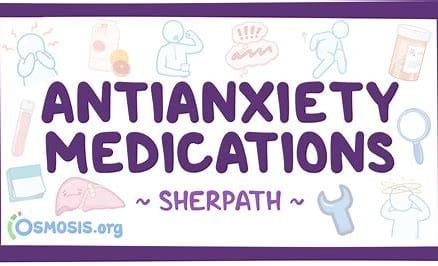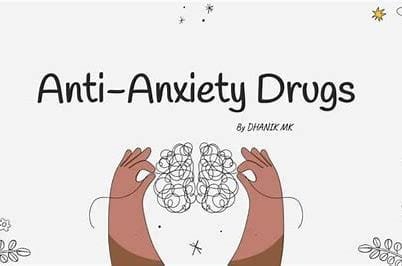Introduction
Anxiety disorders exist among millions of the global population; the prevalence of such disorders can adversely affect quality-of-life conditions with a considerable amount of suffering through physical and psychological illness. To reduce the effects of anxiety disorders, panic disorders, and other such disorders, antianxiety drugs are prescribed, termed anxiolytics. Although these drugs are very effective, they are rather used with caution because risks in adverse effects threaten to give conditions of dependency and other needs that require special formulation. This article will investigate uses, formulation, side effects, and important considerations in using antianxiety drugs.

1. Uses of Antianxiety Drugs
The drug is mainly prescribed for the symptomatology of anxiety disorders, including general anxiety disorder, social anxiety disorder, panic disorder, and post-traumatic stress disorder. These drugs function through attenuation of excessive CNS stimulation, which has resulted in excessive worry or tension, irritability, or physical symptoms such as increased heart rate or sweating.
Benzodiazepines:
These are likely among the most commonly prescribed medications in the treatment of anxiety disorders.
Medications like diazepam (Valium), lorazepam (Ativan), and alprazolam (Xanax) have relatively rapid effects in terms of symptom relief for acute anxiety and therefore are typically shorter-term.
SSRIs:
While SSRIs, including sertraline (Zoloft) and fluoxetine (Prozac), are primarily anti-depressant medications, they are also frequently used in the treatment of chronic anxiety disorders.
Serotonin and Norepinephrine Reuptake Inhibitors (SNRIs):
These include venlafaxine (Effexor) and duloxetine (Cymbalta), which are also used for anxiety disorders.
Beta-blockers and Buspirone:
This is sometimes used as a substitute for benzodiazepines and SSRIs, especially in patients sensitive to other drugs or suffering from certain medical conditions.
2. Preparations of Antianxiety Drugs
There are various forms through which antianxiety drugs are available, including tablets, capsules, liquids, and injections, depending on the specific needs of the patient and the medication type.
Immediate-release formulations:
Most benzodiazepines are available in immediate-release tablets or liquids that are rapidly absorbed and begin to take effect within minutes, thereby providing rapid relief from acute anxiety symptoms. For instance, lorazepam and alprazolam are commonly prescribed in immediate-release formulations for patients with panic attacks.
Long-Acting Formulations:
SSRIs and SNRIs might have extended formulations, thereby granting the steady state of the drug in the body.
For example, drugs that are used to treat chronic anxiety-management need these extended-release medications; this stability of medicine level for chronic conditions is what’s required.
Parenteral injections or infusions or formulations are mostly utilized more in a clinical environment for their acute cases, which might apply when an instance has the patient’s severity with regard to a panic attack. Most appropriately used on patients with such restrictions as they could not perform oral intake, like for an anxious patient.
3. Adverse Side Effects of Anxiolytics
The side effects from antianxiety drugs vary, depending on the type. However, drowsiness, dizziness, difficulty remembering things, and incoordination are common to most. Let’s focus on the side effects most commonly associated with major classes of antianxiety drugs:
Benzodiazepines
Such drugs tend to cause drowsiness, weariness, amnesia, and decreased physical coordination. Eventually, these cause dependence, with withdrawal symptoms when they are stopped abruptly. Long use culminates in tolerance, where larger doses must be administered to affect the same change; these can be dangerous.
SSRIs and SNRIs:
SSRIs may cause nausea, headaches, insomnia, and sexual dysfunction early on. For some, symptoms of anxiety may even temporarily worsen before they begin to improve. SNRIs can cause similar side effects and may also cause elevations in blood pressure.
Beta-blockers are usually very well tolerated but can cause hypotension, dizziness, and fatigue. Beta-blockers are rarely prescribed as first-line antianxiety drugs but can be useful in controlling physical manifestations of anxiety, such as palpitations.
Buspirone:
Buspirone has fewer sedative side effects than benzodiazepines but may induce dizziness, headaches, and nausea. Buspirone is less likely to cause dependence and is therefore safer for long-term use than benzodiazepines.
4. Key Considerations

Antianxiety drugs can be quite effective, but several important factors should be considered both before and during treatment:
The risk of dependence:
Benzodiazepines have a high risk of dependence when used for an extended period. Therefore, they are generally recommended for short-term or intermittent use. Patients with histories of substance abuse might be at a higher risk of becoming dependent and would require other treatments.
Gradual Dose Taper:
Gradual tapering of benzodiazepines and SSRIs should be done under medical care to avoid withdrawal effects.
Pregnancy and Breastfeeding:
Antianxiety drugs are known to have harmful effects on the fetus or can pass through breast milk. Pregnant or lactating women should consult a physician before taking or continuing on antianxiety medication.
Interactions with Other Drugs:
Some of the antianxiety drugs may interact with alcohol, other CNS depressants, or certain medications.
For example, the administration of benzodiazepines in combination with opioids causes severe CNS depression that might lead to respiratory failure.
Alternatives and complementary therapies:
Not everyone responds to or tolerates antianxiety medications. In many cases, lifestyle modifications, mindfulness practices, and cognitive behavioral therapy are advised either as a complement to or as an alternative to medication.
5. Conclusion

This makes antianxiety drugs of much value for the management of anxiety symptoms, especially in the acute attack.
However, the decision for medication, dosage, and duration of treatment should always be individualized because these drugs vary widely in response. Although they bring relief, antianxiety drugs have a risk of possible side effects, and among them, benzodiazepines carry the potential for dependence.
Close monitoring, open communication with a doctor, and adherence to medication dosages can optimize outcomes. Non-medication ways, such as therapy and lifestyle changes, can effectively manage anxiety either alone or in combination with pharmacotherapy.



